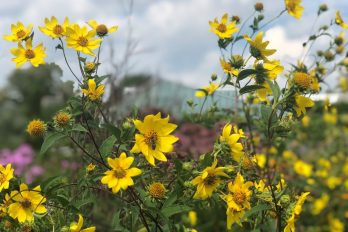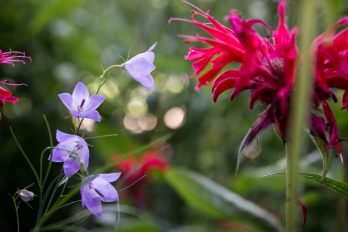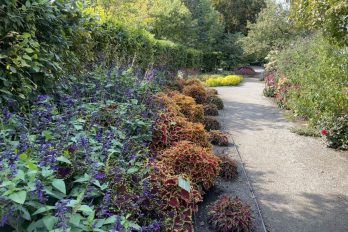The green roof on the Dembroski Centre for Horticulture is over 2400 square feet. It acts as a shallow planter with the soil and plant roots absorbing rainwater and pollutants. It also helps in the control of storm water management by retaining rainwater on the roof, preventing the overload of storm sewers.
The green roof also acts as an insulator by reducing heat gain around the building by way of the “urban heat island effect”. This means less reflected heat off paved or black roof surfaces reduces heat gain in areas of the building, which in turn will reduce the load on air conditioning.
Sloping from front to back affords a view of the roof from the second floor of the building as well as from the West View Terrace and even from Edwards Gardens. The roof provides not only an oasis of green that is pleasurable to look at, but also the opportunity to educate the public on this leading-edge technology. Last, but certainly not least, the green roof demonstrates Toronto Botanical Garden’s commitment to the environment and sustainable development.
Highlights:
- A green roof is an aesthetically pleasing alternative to traditional building materials. This roof is designed to give the appearance of a uniform carpet.
- The sloped portion of the roof was planted in 2005 with a mixture of four low-growing sedums: Sedum album, S. sexangulare, S. spurium and S. kamtschaticum. Once established, these drought resistant plants require little maintenance, and irrigation is necessary only in severe droughts. This form of gardening is known as xeriscape.
- The flat portion of the roof has a variety of native plants and wildflowers.
- Plants on all of the green roof surfaces have become important nectar and pollen resources for the vast range of pollinating insects in the gardens.
- The green roof provides a number of environmental benefits, such as improved insulation for the building below, storm water management through plant absorption and filtration of excess water and improved air quality as plants absorb carbon dioxide and produce oxygen. It also helps to reduce Toronto’s “urban heat island effect”, a phenomenon that causes cities to have higher temperatures than surrounding areas due to a reduction in the natural cover of plant material. Surfaces such as pavement and dark rooftops absorb solar energy and create heat. Plants release water, which uses up heat energy as it evaporates, a process known as evapotranspiration. Green roofs have been shown to significantly reduce the temperature of the air around the building on which they sit.
- The plants are rooted in a growing medium (or soil-less mix) specifically formulated for extensive, non-irrigated and low-maintenance green roofs. Composed of recycled crushed brick, blond peat, perlite, sand and compost, this material resists compaction, thereby providing secure plant anchorage and excellent water retention.
An extension to the flat section of the green roof was added in 2006 through a grant from Wal-Mart and Evergreen.




